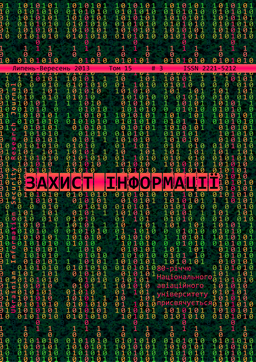Encoding method of dinamik image stationary background in infocommunication system
DOI:
https://doi.org/10.18372/2410-7840.15.4854Keywords:
differential presented frame, alphabet code of size, the binary mask of the predicted frame, the dynamic component, a stationary backgroundAbstract
In order to improve the performance of communication systems is necessary to improve the compression technology of dynamic images. Therefore justified the basic principles of a compression method of dynamic images of stationary background in information and communication systems on the basis of the formation of differential represented by the frame. In order to identify the dynamic component of the threshold set out the terms of use filtration differential represented the frame. The technology of splitting differentially represented on the frame components: the dynamic component, a binary mask stationary background and an array of characters. The technology of processing dynamic component, conducted on the basis of a one-dimensional position-encoding with adaptive selection of the base. The basic steps of the method of processing the binary mask differentially represented by the frame, carried out on the basis of coding capacity of the two lengths of the binary alphabet series. Constructed a matrix decoding technology signs, implemented on the basis of coding capacity alphabet with the structural similarity with the matrix of the binary mask. It is shown that the developed coding methods provide the potential for further reduction in volume and increasing die compression of dynamic images stationary background, which generally leads to a reduction of processing time in information and communication systems.References
Аудиовизуальные системы связи и вещания: новые технологии третьего тысячелетия, задачи и проблемы внедрения в Украине / [О.В. Гофайзен, А.И. Ляхов, Н.К. Михалов и др.] // Пращ УНДІРТ. - 2000. - № 3,- С. 3-40.
Олифер В.Г. Компьютерные сети. Принципы, технологии, протоколы: Учебник для вузов. / В.Г. Олифер, Н.А. Олифер. - СПб.: Питер, 2006. -958 с.
Баранник В.В. Кодирование трансформированных изображений в инфокоммуникационных системах / В.В. Баранник, В.П. Поляков — X.: ХУПС, 2010. - 212 с.
Леках А.А. Анализ информационных технологий обеспечения контроля за грузом и перевозками // Сучасна спеціальна техніка. — 2012. — №3 - С. 34 - 40.
Леках А.А. Обоснование направления разработки технологии сжатия изображений в системе объективного контроля на железнодорожном транспорте// Сучасна спеціальна техніка. — 2012. - №4 - С. 23-29.
Audio-visual communications and broadcasting, new technologies of the third millennium, challenges and problems of implementation in Ukraine, О.У. Gofayzen, A.I. Kyhov. N.K. Mihalov, Pratsi UNDIRT, 2000, №3, P. 3-40.
Olifer V.G. Computer networks. Principles, technologies, protocols: Textbook, V.G. Olifer, N.A. Olifer, SPb.: Piter, 2006, 958 p.
Barannik V.V. Coding transformed images in the information and communication systems, V.V. Barannik, V.P. Polykov, K.:KAFU, 2010, 212p.
Kekakh A.A. Analysis of information technology to ensure control over the cargo and transport, Modern special technique, 2012, № 3, P. 34 - 40.
Tekakh A.A. Justification direction of development of image compression technology in the system of objective control of railway, Modern special tech¬nique, 2012, № 4, P. 23 - 29.
Downloads
Issue
Section
License
Authors who publish with this journal agree to the following terms:- Authors retain copyright and grant the journal right of first publication with the work simultaneously licensed under a Creative Commons Attribution License that allows others to share the work with an acknowledgement of the work's authorship and initial publication in this journal.
- Authors are able to enter into separate, additional contractual arrangements for the non-exclusive distribution of the journal's published version of the work (e.g., post it to an institutional repository or publish it in a book), with an acknowledgement of its initial publication in this journal.
- Authors are permitted and encouraged to post their work online (e.g., in institutional repositories or on their website) prior to and during the submission process, as it can lead to productive exchanges, as well as earlier and greater citation of published work (See The Effect of Open Access).

